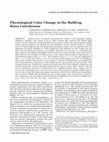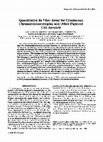Papers by Maria A Visconti
analogue to vulgar vitiligo dermo-epidermal minigrafts 1Hospital Municipal Dr. Fernando Mauro Pir... more analogue to vulgar vitiligo dermo-epidermal minigrafts 1Hospital Municipal Dr. Fernando Mauro Pires da Rocha and

Brazilian Journal of Medical and Biological Research, 2012
Vertebrates have a central clock and also several peripheral clocks. Light responses might result... more Vertebrates have a central clock and also several peripheral clocks. Light responses might result from the integration of light signals by these clocks. The dermal melanophores of Xenopus laevis have a photoreceptor molecule denominated melanopsin (OPN4x). The mechanisms of the circadian clock involve positive and negative feedback. We hypothesize that these dermal melanophores also present peripheral clock characteristics. Using quantitative PCR, we analyzed the pattern of temporal expression of Opn4x and the clock genes Per1, Per2, Bmal1, and Clock in these cells subjected to a 14-h light:10-h dark (14L:10D) regime or constant darkness (DD). Also, in view of the physiological role of melatonin in the dermal melanophores of X. laevis, we determined whether melatonin modulates the expression of these clock genes. These genes show a time-dependent expression pattern when these cells are exposed to 14L:10D, which differs from the pattern observed under DD. Cells kept in DD for 5 days exhibited overall increased mRNA expression for Opn4x and Clock, and a lower expression for Per1, Per2, and Bmal1. When the cells were kept in DD for 5 days and treated with melatonin for 1 h, 24 h before extraction, the mRNA levels tended to decrease for Opn4x and Clock, did not change for Bmal1, and increased for Per1 and Per2 at different Zeitgeber times (ZT). Although these data are limited to one-day data collection, and therefore preliminary, we suggest that the dermal melanophores of X. laevis might have some characteristics of a peripheral clock, and that melatonin modulates, to a certain extent, melanopsin and clock gene expression.
Pigment Cell Research, 1990

8-Methoxy psoralen (8-MOP) exerts a short-term (24 h) mitogenic action, and a long-term (48-72 h)... more 8-Methoxy psoralen (8-MOP) exerts a short-term (24 h) mitogenic action, and a long-term (48-72 h) anti-proliferative and melanogenic action on two human melanoma cell lines, SK-Mel 28 and C32TG. An increase of intracellular calcium concentration was observed by spectrofluorometry immediately after the addition of 0.1 mM 8-MOP to both cell lines, previously incubated with calcium probe fluo-3 AM (5 µM). The intracellular Ca 2+ chelator BAPTA/AM (1 µM) blocked both early (mitogenic) and late (anti-proliferative and melanogenic) 8-MOP effects on both cell lines, thus revealing the importance of the calcium signal in both short-and long-term 8-MOP-evoked responses. Long-term biological assays with 5 and 10 mM tetraethylammonium chloride (TEA, an inhibitor of Ca 2+-dependent K + channels) did not affect the responses to psoralen; however, in 24-h assays 10 mM TEA blocked the proliferative peak, indicating a modulation of Ca 2+dependent K + channels by 8-MOP. No alteration of cAMP basal levels or forskolin-stimulated cAMP levels was promoted by 8-MOP in SK-Mel 28 cells, as determined by radioimmunoassay. However, in C32TG cells forskolin-stimulated cAMP levels were further increased in the presence of 8-MOP. In addition, assays with 1 µM protein kinase C and calcium/calmodulin-dependent kinase inhibitors, Ro 31-8220 and KN-93, respectively, excluded the participation of these kinases in the responses evoked by 8-MOP. Western blot with antibodies anti-phosphotyrosine indicated a 92% increase of the phosphorylated state of a 43-kDa band, suggesting that the phosphorylation of this protein is a component of the cascade that leads to the increase of tyrosinase activity.

Adults of Rana catesbeiana maintained for 4 days in 12:12 light/dark regimen exhibited a rhythmic... more Adults of Rana catesbeiana maintained for 4 days in 12:12 light/dark regimen exhibited a rhythmic color change of 24 hr. Under constant light, however, the rhythm disappeared, and the reflectance values gradually became greater, that is the animals became lighter. Under constant darkness, the rhythm was also abolished, but the animals tended to a darker color. On black background the skin darkening proceeded at a faster rate as compared to the skin lightening of animals adapting to a white background. The difference in color change rate suggests that the darkening responses are probably mediated by an increase in a circulating hormone, whereas skin lightening probably results from the serum level decrease of the same hormone. Most certainly, this hormone is alpha-MSH, as the in vitro assays demonstrated its high potency as a full darkening agonist (EC50 = 9 x 10(-10) M). Prolactin (EC50 = 7.7 x 10(-8) M) and endothelins 2 (EC50 = 1.3 x 10(-6) M) and 3 (EC50 = 4.8 x 10(-7) M) were also full agonists, but 100- to 1000-fold less potent than alpha-MSH. Isoproterenol, in the absence or presence of dibenamine, and endothelin-1 also elicited darkening responses in a dose-related manner, but reaching only 23% and 35% of the maximal darkening, respectively. Isoproterenol darkening effect was completely blocked by propranolol, confirming its action through beta-adrenoceptors. These results, taken together with the lack of lightening activity of norepinephrine on alpha-MSH-darkened skins, suggest that R. catesbeiana melanophores do not possess very active beta-adrenoceptors and lack alpha-adrenoceptors. On the other hand, the lightening agonist melatonin elicited only half-maximal dose-dependent reversal of MSH-induced darkening. Our results suggest that the chromatic rhythm is not endogenous, and most likely is determined by the light/dark cycle effect on alpha-MSH secretion.

Brazilian journal of medical and biological research = Revista brasileira de pesquisas medicas e biologicas, 1996
Chromatophores are specialized integumental stellate cells that synthesize and store pigments. Pi... more Chromatophores are specialized integumental stellate cells that synthesize and store pigments. Pigment granules are translocated within chromatophores of poikilothermic vertebrates and crustaceans in response to photic, thermal and/or neurohormonal stimuli, allowing the animal to rapidly change color for thermoregulation, adaptation to light and background, and social behavior display. Birds and mammals do not show color changes, but may present slow long-term responses, such as melanocyte proliferation, melanin synthesis and melanin granule translocation into feathers, hair and surrounding keratinocytes. Pigment translocation in lower vertebrates as well as pigment production in all vertebrates are modulated by a variety of hormones and neurotransmitters acting on transmembrane receptors located on the cell surface. Alpha-melanocyte-stimulating hormone (alpha-MSH), melanin-concentrating hormone (MCHA), melatonin and catecholamines are the most important pigment cell agonist in vert...

Anais da Academia Brasileira de Ciencias, 1985
We report here the effects of cytochalasin B, colchicine and vinblastine on melanosome migration ... more We report here the effects of cytochalasin B, colchicine and vinblastine on melanosome migration in Papiliochromis ramirezi melanophores. Melanosome migration was not affected by 2 X 10(-5) M cytochalasin B. On the other hand, the aggregation, usually elicited by 10(-6) M norepinephrine, was completely inhibited by simultaneous treatment with 10(-3) M colchicine and cold (0-3 degrees C). Same results were obtained with 10(-3) M vinblastine. Lower concentrations of colchicine had no effect on granule aggregation. However, the aggregation in 50% of the melanophores was still blocked by 10(-5) M vinblastine, whereas 10(-7) M vinblastine was ineffective. Melanosome dispersion usually elicited by 10(-3) M theophylline was significantly accelerated by 10(-3) M colchicine, but delayed by 10(-3) M vinblastine. Lower concentrations of both agents had no effect on pigment dispersion. Therefore our results strongly suggest that microtubule structural integrity is essential to P. ramirezi melan...
Results Chemistry. Nine disulfide bridge contracted analogues (Figure 2) were synthesized. All an... more Results Chemistry. Nine disulfide bridge contracted analogues (Figure 2) were synthesized. All analogues were synthesized by the solid-phase method on 1% cross-linked Merrifield resi, n with dicyclohexylcarbodiimide/N-hydroxy-benzotriazole as the coupling agent. All ...
Progress in clinical and biological research, 1988

Pigment Cell …, 1990
An in vitro crustacean (freshwater shrimp, Macrobrachiurn potiuna) erythrophore bioassay for chro... more An in vitro crustacean (freshwater shrimp, Macrobrachiurn potiuna) erythrophore bioassay for chromatophorotropins and other pigment cell agonists is described. The present assay is a quantitative method that determines the pigment responses with the aid of an ocular micrometer. The pigment granules within the erythrophores are dispersed out into the dendritic processes of the cells when the isolated carapace is placed in physiological solution. This bioassay provides, therefore, a method for measuring the response of the pigment cells to aggregating agents such as pigment concentrating hormone (PCH). This bioassay is sensitive to PCH at a concentration as low as 3 x 10-12M. Calcium ionophore A23187 mimics the actions of PCH, but, unlike the hormone, the ionophoreinduced pigment aggregation is irreversible after physiological solution rinses. Therefore, chromatophorotropic activities of pigment dispersing agents, such as pigment dispersing hormones (PDH), can be determined on ionophore-treated erythrophores. The potencies of a-PDH and p-PDH show a threefold difference (not significant). Because of its convenience and its ability to make an objective determination of the bidirectional pigment movements within erythrophores, this bioassay is a suitable method for further structure-activity studies of the various chromatophorotropins and their analogs.

The biological effects of catecholamines in mammalian pigment cells are poorly understood, but in... more The biological effects of catecholamines in mammalian pigment cells are poorly understood, but in poikilothermic vertebrates they regulate the translocation of pigment granules. We have previously demonstrated in SK-Mel 23-human melanoma cells the presence of low affinity 1-adrenoceptors, which mediate a decrease in cell proliferation and increase in tyrosinase activity, with no change of tyrosinase expression. In this report, we investigated the signalling pathways involved in these responses. Calcium mobilization in response to phenylephrine (PHE), an 1-adrenergic agonist, was investigated by confocal microscopy, and no change of fluorescence during the treatment was observed, suggesting that calcium is not involved in the signalling pathway activated by 1-adrenoceptors in SK-Mel 23 cells. cAMP levels, determined by enzyme-immunoassay, were significantly increased by PHE (10 À5-10 À4 M), that could be blocked by the 1-adrenergic antagonist benoxathian (10 À5-10 À4 M). Several biological assays were then performed with PHE, for 72 h, in the absence or presence of various signalling pathway inhibitors, in an attempt to determine the intracellular messengers involved in the responses of proliferation and tyrosinase activity. Our results suggest the participation of p38 and ERKs in PHE-induced decrease of proliferation, and possibly also of cAMP and protein kinase A. Regarding PHE-induced increase of tyrosinase activity, it is suggested that the following signalling components are involved: cAMP/PKA, PKC, PI3K, p38 and ERKs.
… and Physiology-Part A: …, 2007
Several reports have shown the participation of vasoactive endothelins (ETs) in the regulation of... more Several reports have shown the participation of vasoactive endothelins (ETs) in the regulation of vertebrate pigment cells. In the present study, we identified ET receptors in pigment cells of vertebrate species by RT-PCR assays, and compared the differential expression of the ...

Neotropical Ichthyology
Organisms with source-populations restricted to the subterranean biotope (troglobites) are excell... more Organisms with source-populations restricted to the subterranean biotope (troglobites) are excellent models for comparative evolutionary studies, due to their specialization to permanent absence of light. Eye and dark pigment regression are characteristics of most troglobites. In spite of the advance in knowledge on the mechanisms behind eye regression in cave fishes, very little is known about pigmentation changes. Studies were focused on three species of the genus Pimelodella. Exemplars of the troglobitic P. spelaea and P. kronei were compared with the epigean (surface) P. transitoria, putative sister-species of the latter. Melanophore areas and densities are significantly lower in the troglobitic species. Evaluating the in vitro response of these cells to adrenaline, acetylcholine and MCH, we observed a reduced response in both troglobites to adrenaline. The same trend was observed with MCH, but not statistically significant. No response to acetilcholine was detected in all the t...

Physiology & Behavior
Body coloration has a fundamental role in animal communication by signaling sex, age, reproductiv... more Body coloration has a fundamental role in animal communication by signaling sex, age, reproductive behavior, aggression, etc. Nile-tilapia exhibits dominance hierarchy and the dominants are paler than subordinates. During social interactions in these animals, these color changes occur rapidly, and normally the subordinates become dark. In teleosteans, from the great number of hormones and neurotransmitters involved in color changes, melanocyte hormone stimulates (α-MSH) and melanin concentrates hormone (MCH) are the most remarkable. The aim of this project was to investigate the role of MCH in the establishment of hierarchical dominance of the Nile-tilapia. We analyzed the effect of background coloration in the dominance hierarchy. It was then compared to the melanophore sensibility of dominants and subordinates' fishes to MCH; finally, it was checked if the social rank affects the number of these pigment cells in dominants and subordinated fishes. Fishes which have a social hierarchy established and adjusted individually to the background exhibits paler body coloration when a visual contact was possible, independently of previous social rank and background color. Probably, even recognizing each other, fishes could be defending their new territory. Melanophores of the subordinate fishes were more sensible to MCH than dominants. It suggests that dominants fishes, which are paler than subordinates, could be under a chronic effect of MCH, which could be due a desensitization of melanophores to this hormone. The opposite effect seems to be occurring on subordinate fishes. It was not observed a significant change in the number of melanophores when the fishes were exposed to a prolonged period of agonistic interaction. It is possible that the exposure time for this interaction might not have been sufficient to have any change in the number of these cells of dominants and subordinate fishes.

Comparative Biochemistry and Physiology Part C Comparative Pharmacology, 1985
The adverse effects of tris (hydroxymethyl)-aminomethane (Tris) are for the first time reported o... more The adverse effects of tris (hydroxymethyl)-aminomethane (Tris) are for the first time reported on melanophore responses to agonists and potassium chloride. 2. Melanophore responses in Tris-or bicarbonate-buffered solutions were compared. 3. In the presence of Tris, the cumulative dose-response curve to norepinephrine was significantly shifted to the left. whereas methoxamine dose-response curves were similar in both buffers. 4. The percentage aggregation in response to synthetic MCH (melanin concentrating hormone) was not affected by Tris in the bathing medium. 5. The cumulative dose-response curve to potassium chloride was leftward shifted (one log case) in Tris-buffered solution. 6. These results suggest that in fish melanophore preparations Tris might exert its actions on the presynaptic membrane and/or on the synaptic cleft enzyme COMT, drawing on a greater availability of neurotransmitters at the melanophore membrane receptors.
Brazilian Journal of Medical and Biological Research
ABSTRACT


Uploads
Papers by Maria A Visconti